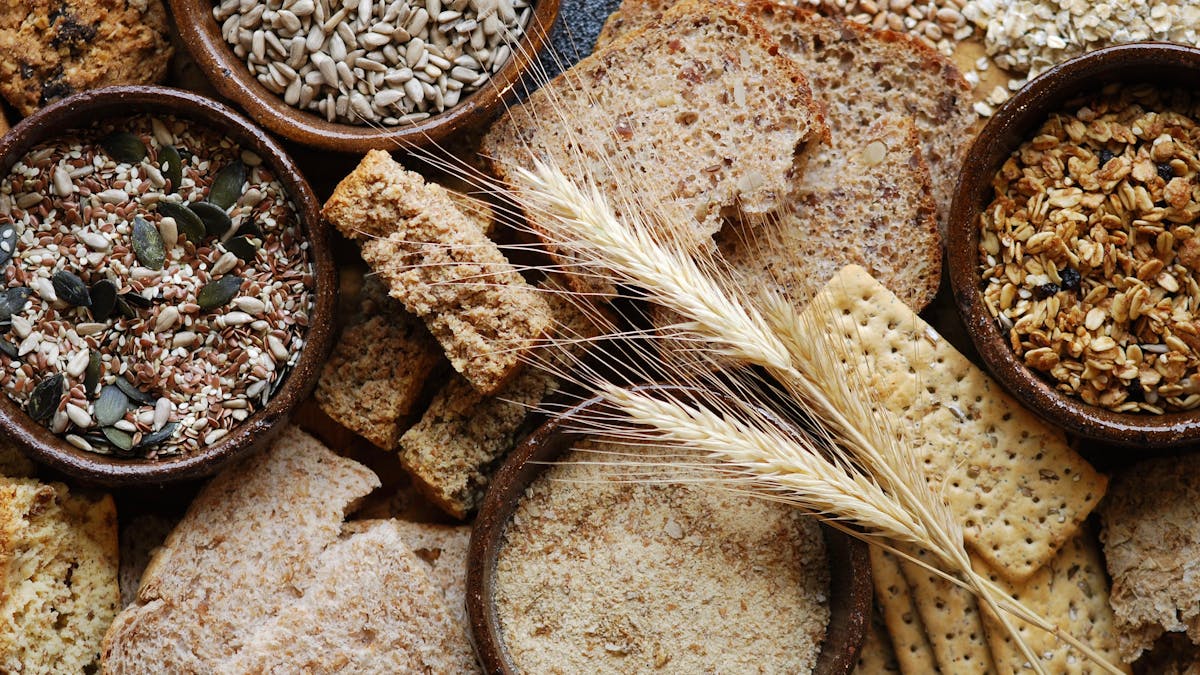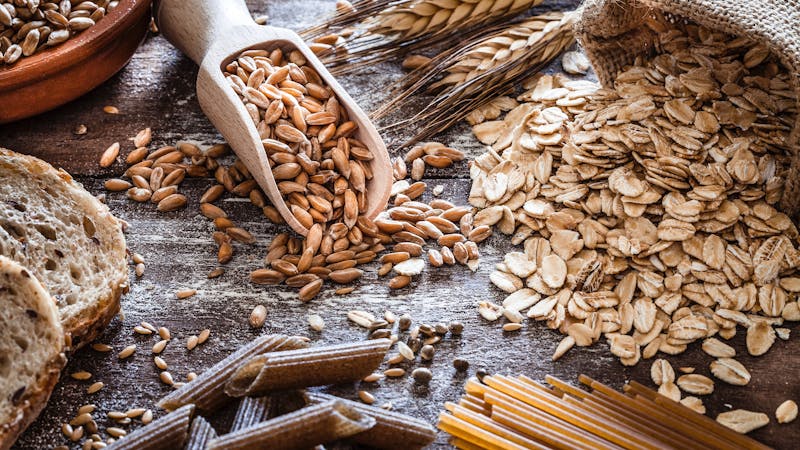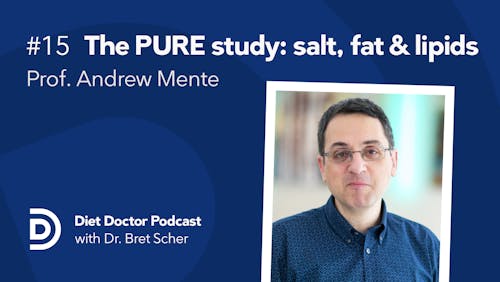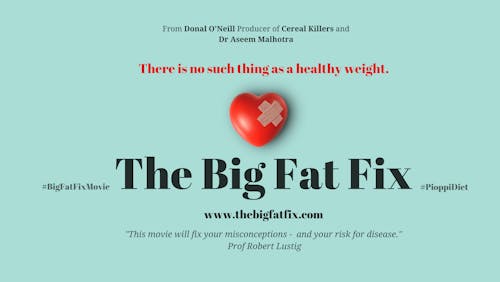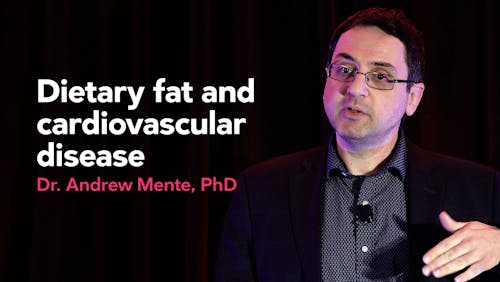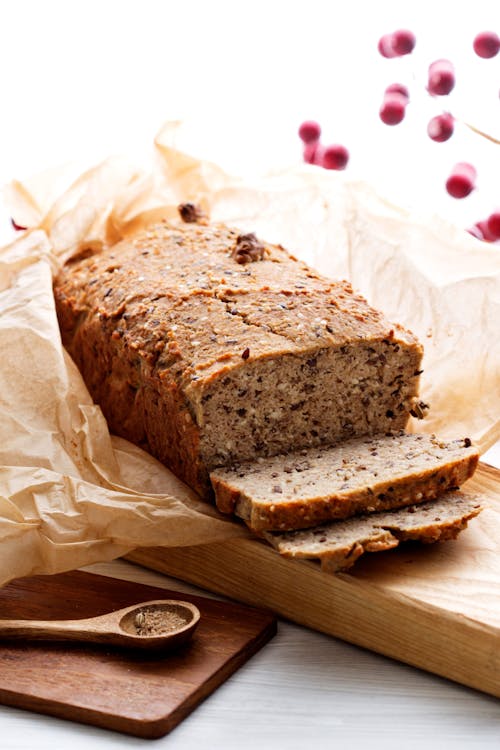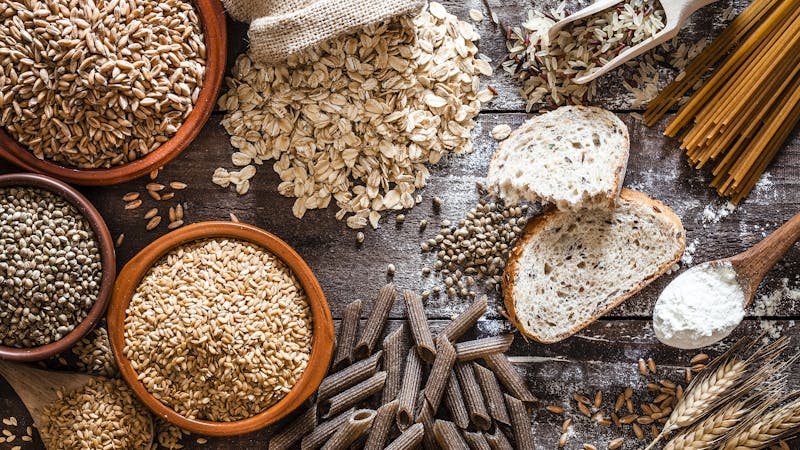“Healthy” whole grains: What the evidence really shows
You hear about them all the time: those nutritious whole grains you should be eating every day if your goals include being slim and healthy — and whose goals don’t include that?
Do whole grains live up to their reputation as a superfood? Let’s take a closer look at the scientific evidence behind the claims made about their benefits. Then you can decide whether or not you need a daily dose of grains in your diet.
This guide is our attempt at summarizing what is known. It is written for adults who are concerned about whole grain intake and health.
Discuss any lifestyle changes with your doctor. Full disclaimer
First, what are whole grains?
Technically, whole grains are the seeds of cereal grasses. In their natural “whole” state, grains have a hard, inedible husk that covers three edible parts:
- Bran: fiber
- Germ: contains some B vitamins, minerals, fat, and protein
- Endosperm: major portion of the grain; mainly starch with a small amount of protein, vitamins and minerals
Nutritionally speaking, whole grains have had their outer inedible husks removed but retain all three edible parts of the seed. By contrast, refined grains like white flour (including unbleached wheat flour) and white rice have their bran and germ removed during milling, leaving only the endosperm.
Most whole grains have some processing. For instance, whole wheat is ground or crushed to create whole-wheat flour; old-fashioned oats are steamed and rolled in order to make them more palatable and easier to digest.
Wild grains appear to have been eaten by hunter-gatherers in certain regions during the paleolithic era, including the areas known today as Southern Italy and Africa.2 During the Agricultural Revolution, larger quantities of wheat, barley, rice and other grains were grown and became a part of the human diet in many other areas.
Since then, people around the world have consumed a variety of grains based on cultural preferences and availability. Among the dozens of types of whole grains that exist, some of the most well-known and widely consumed include:
- Barley
- Brown rice
- Bulgur
- Corn
- Oats
- Rye
- Whole wheat
- Wild rice
According to the Whole Grains Council, the most commonly consumed whole grains in the US are whole wheat, oats, and brown rice.
Buyer beware: over the past several decades, the term “whole grains” has become a buzzword among the health conscious. Knowing this, manufacturers often include bold, eye-catching messages like “Contains 14 grams of whole grains” on boxes of cereal, whole-wheat pasta, granola bars and similar products, which often contain high levels of added sugar.
In fact, a 2013 review of more than 500 grain-based products found that those displaying a “whole grains” stamp contained more sugar — and were more expensive — than similar products without the stamp.3
Nutrition in whole grains
Are whole grains really a nutrient-packed energy source? That depends to what we compare them. While some types contain a bit more protein and micronutrients than others, they aren’t necessarily nutrient-rich when considered in the context of their carbohydrate and calorie content.4
For instance, a 40-gram (1/4 cup) serving of steel-cut oats — often suggested as an ideal meal to start your day — provides about 5 grams of protein (although this is considered “incomplete” protein since it lacks some of the essential amino acids), 4 grams of fiber (daily recommendations are around 30 grams per day), and about 10-20% of daily thiamin, iron, magnesium, biotin, selenium and zinc requirements. However, it also contains about 23 grams of net carbs and 150 calories, even when prepared without milk, fruit, sweeteners or other additives. Compare that to the recommended less than 20 grams of net carbs per day for very low carb diets, and less than 50 grams for low carb diets.
How about using two slices of whole wheat bread to build your sandwich at lunch? This would provide about 8 grams of (incomplete) protein, a quarter of your daily selenium needs, and small amounts of thiamin, niacin, and magnesium, which would come with approximately 180 calories, 35 grams of net carbs and a comparably low 6 grams of fiber.
Brown rice’s nutritional profile is similar to that of whole wheat bread and oats, although even lower in protein and fiber.
Newly popular grains like quinoa and farro are often lauded for being higher in protein and fiber than rice or pasta. While this may be true, they too are relatively high in net carbs, meaning that you’d need to eat a number of portions per day (and a lot of carbs) to meet protein and micronutrient requirements. If you would like to follow a lower carb way of eating, there are more suitable ways of getting the vitamins and minerals you need.
Whole grains also contain phytonutrients, which are compounds found in plants that appear to protect cells from damage and reduce inflammation in the body. It has been postulated that phytonutrients may be at least partly responsible for some of the health benefits that have been attributed to whole grains. However, higher-quality studies are needed to confirm this.5
There are copious mechanistic and epidemiologic data suggesting that phytonutrients are beneficial, but we certainly do not need to eat whole grains to obtain them. Many plant-derived foods contain these compounds, such as olives, nuts and even oils. Therefore, you don’t have to sacrifice phytonutrients if you prefer eating low carb. In addition, there is no evidence that you need phytonutrients to be healthy.
And that leads us to the quality of the existing research on whole grains and health.
Whole-grain research: weak evidence overall
Studies about whole grains seem to receive more than their fair share of media coverage. One such item to make recent international news headlines was a series of systematic reviews and meta-analyses exploring the health effects of different types of carbohydrate, which was published in The Lancet early in 2019.After analyzing 185 observational studies and 58 clinical trials, researchers concluded that eating more whole grains and fiber might be an effective strategy for preventing obesity, heart disease, diabetes, cancer, and reducing risk of early death.6
We wrote about that review when it came out, noting that it compared diets with whole grains to other high carb diets low in whole grains. Although it was not explicitly stated, this often means the control diets contained lots of refined grains (We also addressed the erroneous myth that low carb diets are necessarily low-fiber diets. They are not!). And we wondered how the results would have been different if the comparison group ate a low carb, no-grain diet.
Diet Doctor: A low-carb diet does not mean a low-fiber diet
We can conclude that there is ample evidence for whole grains’ beneficial health effects compared to high carb diets that are low in whole grains. While many of these studies are low-quality nutritional epidemiology studies, some of the data come from interventional clinical trials and are stronger. Yet the question remains how this all should apply to answering whether low carb diets are superior to higher carb diets rich in whole grains.7
Learn more about observational vs. experimental studies:

Guide to observational vs. experimental studies
Guide In this guide, we discuss the differences between observational and experimental studies, the advantages and disadvantages of each.
Whole grains are promoted as a healthy product; they are typically chosen and eaten by people who prioritize health. Therefore, these people not only eat whole grains, they also tend to engage in a whole host of healthy behaviors – like not smoking, eating lots of fruit and vegetables, and exercising. Thus, the association between whole-grain consumption and good health is a perfect example of “healthy user bias.”8
Take the example of the “Blue Zones,” small sections of the world where people live to be 100 years old far more frequently than the general population. They are reported to eat lots of whole grains. But we don’t know if they are healthier because of the whole grains or because they tend to practice many other health-conscious behaviors like exercising regularly, drinking alcohol in moderation, avoiding sugar-sweetened beverages and cooking fresh food at home on a regular basis.
Observational studies are also limited by “social desirability bias.” This is where people taking part in a study respond in a certain way in order to please the researchers.9 Since whole grains are promoted as healthy for us, many people may respond, “Yes, of course, every day!” to the question “Do you eat wholegrain bread?”— even when they prefer and tend to consume white bread! This makes it harder to rely on self-reported dietary intake of healthy foods.
Given the limitations of nutritional epidemiology data, how can we better understand the impact of whole grains? Let’s examine the higher-quality randomized controlled trial (RCT) evidence to see how well it supports the claim that whole grains can improve your health.
RCTs are designed to compare an intervention (such as consuming more whole grains) with a control (such as consuming refined grains). In these whole grain RCT studies, we need to know to what the whole grains were compared. Did they compare eating whole grains to eating refined grains? Or to low carb vegetables? As you will see, it makes a difference.
Whole grains and weight loss
Many nutrition authorities, including the Dietary Guidelines for Americans, keep sharing this message: “Eating plenty of whole grains, as part of an overall healthy diet, may help with weight management.”10 But how strong is the evidence linking high whole-grain intake and weight loss?
A 2013 systematic review of RCTs — considered the strongest type of evidence — found slightly higher fat loss (less than 0.5% difference) with no difference in overall weight loss in groups who consumed diets high in whole grains compared to groups who consumed refined grains.11 A newer systematic review published in 2020 found no weight loss benefit from whole-grain consumption.12
In other words, the majority of RCTs show the effect of whole grains on weight loss to be negligible at best. However, some studies do show other beneficial effects.
Several RCT studies have found that among normal weight and overweight adults, those who consumed whole grains compared to refined grains for four to 16 weeks experienced greater increases in resting metabolic rate and greater decreases in belly fat, insulin resistance, inflammation and body weight.13
In one study, people who ate whole rye products had greater fat loss compared to those who consumed refined grains. The same was not found for wholegrain wheat.14
Bottom line: RCTs show that eating whole grains has a minimal impact on reducing body weight. However, replacing refined grains with whole grains likely has more significant benefits. Therefore, it is likely that some of the benefit of eating more whole grains comes from eating less refined grains, in addition to small, if any, beneficial effects of the whole grains themselves.
Whole grains and diabetes
Can eating whole grains on a regular basis help prevent type 2 diabetes and blood sugar spikes?
Once again, observational trials show an association between eating whole grains and lowering the risk of developing type 2 diabetes. We have already reviewed the weaknesses of this type of data and explained how observational studies cannot prove there is a beneficial effect of whole grains. So, one must ask: how does the claim hold up under the scrutiny of higher-quality randomized controlled trials (RCTs)?
A randomized controlled trial specifically designed to test the effect of the fibers from whole grains on type 2 diabetes development found that wholegrain fibers were not significantly better than the control arm at lowering glucose or improving insulin sensitivity. There was no difference between the groups in the incidence of type 2 diabetes.15
Results from other experimental trials looking at blood sugar response to whole grains have been mixed. A 2017 systematic review of RCTs found that whole grains don’t raise post-meal blood sugar and insulin levels as much as refined grains do, at least in healthy people.16
However, an even more recent review of RCTs showed that individuals without diabetes had almost identical blood sugar responses after eating whole vs. refined wheat or rye. The blood sugar increase was much higher after eating white rice compared to whole-grain rice, though.17
At this time, there are a number of RCTs demonstrating that replacing processed grains with whole grains improves blood sugar and insulin regulation in obese people and those with diabetes.18 Again, this does not address whether eating whole grains is more beneficial than eating no grains.
So is this a good strategy for improving control of diabetes? That depends. If you are replacing highly refined grains, then whole grains are likely beneficial. But how does this compare to diabetes control without grains?
Multiple randomized trials show better glycemic control with carbohydrate restriction. This by definition means the participants excluded or significantly reduced grains. Systematic reviews of the RCTs confirm these results.19 And the American Diabetes Association (ADA) now says “Reducing overall carbohydrate intake for individuals with diabetes has demonstrated the most evidence for improving glycemia and may be applied in a variety of eating patterns that meet individual needs and preferences.”20
Whole grains can increase blood sugar more than commonly believed
Whole grains rank surprisingly high on the glycemic index (GI), the scale that measures how much a specific food raises blood sugar.21
The amount of processing grains undergo will influence their GI. Yet even minimally processed steel-cut oats have a moderate GI of 55, and quick-cooking oatmeal has a GI over 70.22 By contrast, cabbage and spinach have very low GIs of 15 and 6, respectively, and meat, fish, cheese, and fats are zero-GI foods.
As we already mentioned, whole grains have been shown to raise people’s blood sugar levels less than refined grains do in most experimental studies. But what is the blood sugar response to extremely low-grain or entirely grain-free diets?
The benefits of low carb and very low carb diets for blood sugar control in type 2 diabetes have been documented in several systematic reviews and meta-analyses of RCTs.23
And Virta Health’s ongoing non-randomized trial of a long-term, very low carb ketogenic diet for the treatment of diabetes has produced remarkable results.24
The paleo diet, which excludes grains entirely, has been found to be effective for lowering blood sugar and insulin levels in some randomized clinical trials. Interestingly, when the diet was examined by two meta-analyses of these RCTs, it was not found to be more effective than conventional dietary recommendations for lowering blood sugar and insulin levels in people at risk for metabolic syndrome.25
Bottom line: Replacing refined grains with whole grains likely has significant benefits for blood sugar control. However, even whole grains raise blood glucose, so completely avoiding grains seems to result in even better blood sugar control.
Whole grains and heart disease
Whole grains are often referred to as “heart-healthy” foods.
Indeed, many epidemiology studies show those who eat whole grains have a lower risk of heart disease. However, as mentioned earlier, this does not prove that whole grains directly improve heart health, and given the inherent weakness of the data, we believe it is just as likely due to healthy user bias (healthier people choose to eat whole grains and therefore have other healthy habits that contribute to a lower risk of heart disease).
On the other hand, higher-quality experimental studies frequently show improvements in certain heart disease risk factors when whole grains are substituted for refined grains. Two meta-analyses of RCTs found minor reductions in LDL cholesterol in groups that consumed whole grains compared to groups that consumed refined grains, with oats appearing to have the most cholesterol-lowering power. There was no significant change in triglycerides.26
However, reducing isolated risk factors does not necessarily translate into improved health, especially if one marker improves while others worsen (such as LDL improving but insulin resistance worsening.) That is why we need experimental studies looking at the endpoints that really matter – heart attacks, strokes and death – as opposed to surrogate outcomes like LDL. To date, those studies are lacking.
Moreover, in 2017, the Cochrane Database performed a systematic review of nine RCTs and concluded there isn’t enough evidence to support claims that whole grains lower CVD risk. They drew that conclusion due to the overall low quality of the research, which suffered from small sample sizes, short-term interventions, and a high risk of bias (including funding from pro-cereal organizations).27
A 2020 systematic review of 25 RCTs found that whole grains may mildly reduce some heart disease risk factors. The low magnitude of the results and lack of measured hard outcomes (e.g., heart attack, stroke) calls into question the clinical relevance of these findings.28
This highlights the importance of understanding how low-quality research has influenced support for the “heart-healthy” claim for whole grains. When scrutinized critically, the data don’t seem to hold up.
At this point in time, we can probably say that eating whole grains instead of refined grains is a good idea based on available evidence, but the research does not prove that we need whole grains in the diet to reduce our risk of CVD.
Whole grains and cancer risk
Cancer agencies and other groups often promote whole grains as a food that helps prevent cancer. This is based mostly on observational studies showing that people who eat the most whole grains are at lower risk for certain cancers, especially colorectal cancer. However, these conclusions are weakened by the studies’ low hazard ratios and by the fact that many other epidemiology studies fail to confirm the findings.29
As with most nutrition research, one major challenge of these studies is the accurate assessment of dietary intake. While biomarkers for whole grain intake have been studied, they have significant limitations, including a short half-life.30 This is especially important when looking at bowel cancer prevention because a large amount of fiber might be needed, which is very difficult to accurately assess.31
What’s more, experimental research (RCTs) testing the effect of consuming whole grains on cancer risk is entirely lacking. One reason for this is likely the lead time required to see the impact of any intervention. The development and growth of a cancer is a process that often takes many years, making it imperative to follow subjects for a very long time; this can be prohibitively expensive and impractical.
Therefore, what we’re left with are observational studies, some of which show association, many of which don’t, and none of which can prove causation. And as with other observational nutrition studies, we don’t know if healthier people chose to eat more grains, or if eating the grains made them healthier. Nor do we know if whole grains are simply a surrogate for food quality and fiber when compared to a diet full of refined and processed foods.
Bottom line: If whole grains replace refined grains and highly processed foods, then eating whole grains may be associated with reduced cancer incidence. However, based on the conflicting results of low-quality observational studies and lack of RCT evidence, at this point there’s no convincing evidence that whole grains by themselves are protective against cancer.
Whole grains and other attributed health benefits
Whole grains have also been linked to a few other health improvements:
- Reduced inflammation: Inflammation is believed to be at the root of many chronic diseases, including heart disease.32 Two meta-analyses of RCTs found that consuming whole grains instead of refined grains helped reduce the inflammatory markers C-reactive protein (CRP) and interleukin-6 (IL-6).33
- Better gut health: Bacteria that reside in your colon produce short-chain fatty acids as a byproduct of fermenting fiber. Results from RCTs suggest that consuming whole grains seems to boost production of these short-chain fatty acids, which nourish the gut and may improve insulin sensitivity.34
While these studies may sound convincing, keep in mind that they are not comparing whole grains to a grain-free, low carb diet, but rather to the consumption of highly refined grains. While the fiber content of whole grains may very well play a role in these beneficial health effects, you can consume a wide range of different fibers in the context of a low carb diet by eating nuts, seeds, avocados, low-carb fruits, and non-starchy vegetables.
Dietary guidelines videos
Comparing whole grains to no grains
To recap, the RCTs to date of whole grains demonstrate that, yes, eating a less-processed food is better than eating a highly-processed one.
What if studies compared consuming three servings of whole grains to three servings of non-starchy vegetables per day on a low carb diet? In the context of such an RCT, whole grains might not show any benefit. But we don’t know that because, to the best of our knowledge, such a trial has never been conducted.
One RCT, however, suggests that the no-grain approach might be superior. Although not a head-to-head trial pitting whole grains vs. no grains, back in 2007 researchers compared a grain-free, very low carb, ketogenic diet to a low-glycemic-index (low-GI) diet that included whole grains, in adults with type 2 diabetes.
At the end of the six-month trial, people in the grain-free keto group had significantly greater weight loss and reductions in blood sugar than the low-GI group.35
Whole grains don’t provide unique nutritional benefits
While it’s true that whole grains contain vitamins, minerals, fiber, and polyphenols, these nutrients are found in many other foods, often in greater concentrations:
- Fiber: Looking for fiber? Eat cruciferous vegetables, flaxseed, chia seeds, nuts, avocados, blackberries and raspberries — all of which provide more fiber than whole grains and far fewer digestible carbohydrates.
- Magnesium: Although most whole grains are considered a good source of magnesium, mackerel, cooked greens, almonds, hemp seeds, pumpkin seeds, and sunflower seeds contain equivalent or greater amounts per serving.
- Thiamin: Seafood has the edge over whole grains for thiamin, and pork is higher in this B vitamin than any other food.
- Niacin: Chicken, turkey, red meat (especially liver), fatty fish, and avocado are better sources of niacin than whole grains.
- Polyphenols: The jury is still out when it comes to the magnitude of effect of plant phenols on health. However, you certainly don’t need to consume whole grains to get them. Vegetables, berries, olive oil, tea, spices, coffee, and dark chocolate contain an array of potentially beneficial polyphenols.36
Tolerance for whole grains varies among individuals
Some people can eat whole grains regularly without experiencing any issues. Others, however, cannot.
Individuals with celiac disease need to avoid gluten-containing whole grains. Gluten — a protein found in wheat, barley, rye and the wheat derivatives farro, spelt and triticale — can cause damage to the digestive tract and other symptoms when consumed in even small amounts by those with celiac disease.
People with celiac disease or non-celiac gluten sensitivity must eat a gluten-free diet in order not to experience symptoms.37 These individuals may be able to tolerate other types of whole grains like brown rice or quinoa. However, they might benefit from avoiding all grains, as even types that don’t naturally contain gluten are sometimes cross-contaminated with those that do during processing and packaging.38
There are also people for whom whole grains might cause other problems, such as IBS.39
Summary: should we eat whole grains or avoid them?
Whole grains have a clear edge over refined grains, with many studies showing they are better with respect to many health-related outcomes. However, there’s a lack of high-quality evidence comparing diets high in whole grains to grain-free diets.
This means that for people who tolerate grains and enjoy eating them, minimally processed and whole grain types are likely best. But if you don’t feel a need to eat grains, they do not appear to confer any unique nutritional or health benefits that can’t be found in other foods.
Recommendations to consume whole grains regularly to promote better health are not based on high-quality scientific evidence.
What’s more, given their high carbohydrate content, they probably shouldn’t be consumed very often on a low carb diet, if at all. Fortunately, Diet Doctor has plenty of tasty, grain-free, low carb bread and porridge recipes available that can be enjoyed instead.
Do you need whole grains? In all likelihood, no. At the end of the day, you can obtain health benefits from eating a wide variety of low carb whole foods that are delicious, satisfying, and often nutritionally superior to whole grains.
Start your FREE 7-day trial!
Get instant access to healthy low-carb and keto meal plans, fast and easy recipes, weight loss advice from medical experts, and so much more. A healthier life starts now with your free trial!
Start FREE trial!Our most popular low-carb bread recipes
“Healthy” whole grains: what the evidence really shows - the evidence
This guide is written by Franziska Spritzler, RD and was last updated on June 19, 2025. It was medically reviewed by Nicola Guess, RD MPH PhD on July 14, 2022.
The guide contains scientific references. You can find these in the notes throughout the text, and click the links to read the peer-reviewed scientific papers. When appropriate we include a grading of the strength of the evidence, with a link to our policy on this. Our evidence-based guides are updated at least once per year to reflect and reference the latest science on the topic.
All our evidence-based health guides are written or reviewed by medical doctors who are experts on the topic. To stay unbiased we show no ads, sell no physical products, and take no money from the industry. We're fully funded by the people, via an optional membership. Most information at Diet Doctor is free forever.
Read more about our policies and work with evidence-based guides, nutritional controversies, our editorial team, and our medical review board.
Should you find any inaccuracy in this guide, please email andreas@dietdoctor.com.
Cochrane Database of Systematic Reviews 2017: Whole grain cereals for the primary or secondary prevention of cardiovascular disease [strong evidence] ↩
Proceedings of the National Academy of Sciences of America 2015: Multistep food plant processing at Grotta Paglicci (Southern Italy) around 32,600 cal B.P. [historical data; ungraded]
Science 2009: Mozambican grass seed consumption during the Middle Stone Age [historical data; ungraded] ↩
Public Health Nutrition 2013: Identifying whole-grain foods: a comparison of different approaches for selecting more healthful whole grain products [overview article; ungraded] ↩
Whole Grains Council: Whole grains: an important source of essential nutrients [overview article; ungraded] ↩
Nutrients 2018: Whole grains and phenolic acids: a review on bioactivity, functionality, health benefits and bioavailability [overview article; ungraded] ↩
The Lancet 2019: Carbohydrate quality and human health: a series of systematic reviews and meta-analyses[Meta-analysis of observational and randomized clinical trial data; weak evidence] ↩
As an example, a large nutritional epidemiology study, the PURE study, reported that the intake of whole grains had no association with cardiovascular risk, either positive or negative. Refined grains, on the other hand, had an association with increased cardiac risk. Keep in mind this represents the very weak nutritional epidemiology on which much of the whole grain literature is based:
BMJ 2021: Associations of cereal grains intake with cardiovascular disease and mortality across 21 countries in Prospective Urban and Rural Epidemiology study: prospective cohort study [nutritional epidemiology study; very weak evidence] ↩
These observational studies attempt to control for specific factors such as smoking, exercising, etc. However, we believe it is incredibly difficult to accurately control for these behaviors, and nearly impossible to control for healthy/unhealthy behaviors that weren’t measured (e.g., How well did they manage their stress? How often did they engage with a supportive social network? Did they prioritize their health or not pay much attention to health?) ↩
Journal of Nutrition 2008: Social desirability trait influences on self-reported dietary measures among diverse participants in a multicenter multiple risk factor trial [observational study, weak evidence] ↩
This quote is taken from the ChooseMyPlate website
↩American Journal of Clinical Nutrition 2013: Whole grain and body weight changes in apparently healthy adults: a systematic review and meta-analysis of randomized controlled studies [strong evidence] ↩
Advances in Nutrition 2020: Whole-grain consumption does not affect obesity measures: An updated systematic review and meta-analysis of randomized clinical trials [strong evidence] ↩
Resting metabolic rate:
American Journal of Clinical Nutrition 2017: Substituting whole grains for refined grains in a 6-wk randomized trial favorably affects energy-balance metrics in healthy men and postmenopausal women [moderate evidence]
Belly fat:
Plant Foods for Human Nutrition 2018: Effects of whole grain wheat bread on visceral fat obesity in Japanese subjects: a randomized double-blind study [moderate evidence]
Insulin resistance:
Metabolism 2018: A whole-grain diet reduces peripheral insulin resistance and improves glucose kinetics in obese adults: A randomized-controlled trial [moderate evidence]
Inflammation and body weight:
Eating and Weight Disorders 2020: Effects of dietary whole grain, fruit, and vegetables on weight and inflammatory biomarkers in overweight and obese women [randomized trial; moderate evidence]
Gut-British Medical Journal 2019: Whole grain-rich diet reduces body weight and systemic low-grade inflammation without inducing major changes of the gut microbiome: a randomised cross-over trial [moderate evidence] ↩
European Journal of Clinical Nutrition 2017: Wholegrain rye, but not wholegrain wheat, lowers body weight and fat mass compared with refined wheat: a 6-week randomized study [moderate evidence] ↩
This study could be interpreted to mean that the addition of whole grains to a diet would not be sufficient to prevent type 2 diabetes. However, the insoluble fiber was given as a supplement at a dose of 7.5 grams twice daily. This might be handled differently by the body, as compared to actually eating an amount of whole grains that contains the same quantity of fiber. Therefore, the negative results of this study should not be over-interpreted.
Diabetologia 2018: Fibre supplementation for the prevention of type 2 diabetes and improvement of glucose metabolism: the randomised controlled Optimal Fibre Trial (OptiFiT) [randomized trial; moderate evidence] ↩
Nutrients 2017: Whole grain intake and glycaemic control in healthy subjects: a systematic review and meta-analysis of randomized controlled trials [strong evidence] ↩
The mostly negative results of this paper should be interpreted with caution, as the food consumed in the trials was made with either whole-grain flour or refined flour. There appears to be a difference between eating a whole grain that has been minimally processed vs. eating that same whole grain after grinding into a flour. Therefore, we must keep in mind that this paper doesn’t adequately disprove the idea that minimally processed whole grains are better for blood sugar control than more processed whole grains.
American Journal of Clinical Nutrition 2018: The effects of whole-grain compared with refined wheat, rice, and rye on the postprandial blood glucose response: a systematic review and meta-analysis of randomized controlled trials [strong evidence]
This RCT shows better blood sugar control overall with minimally processed whole grains compared to finely milled whole grains:
Diabetes Care 2020: Whole-grain processing and glycemic control in type 2 diabetes: a randomized crossover trial
[randomized trial; moderate evidence] ↩PLoS Medicine 2020: Dietary fibre and whole grains in diabetes management: Systematic review and meta-analyses[Meta-analysis of observational and randomized clinical trial data; weak evidence]
Nutrients 2016: Short- and long-term effects of wholegrain oat intake on weight management and glucolipid metabolism in overweight type-2 diabetics: a randomized control trial [moderate evidence]
Metabolism 2018: A whole-grain diet reduces peripheral insulin resistance and improves glucose kinetics in obese adults: A randomized-controlled trial [moderate evidence]
American Journal of Clinical Nutrition 2014: Effects of whole and refined grains in a weight-loss diet on markers of metabolic syndrome in individuals with increased waist circumference: a randomized controlled-feeding trial [moderate evidence] ↩
The advantage of a low carb diet in type 2 diabetes has been recognized in several systematic reviews and meta-analyses or RCTs. Here are two recent examples:
Diabetes Research and Clinical Practice 2018: Effect of dietary carbohydrate restriction on glycemic control in adults with diabetes: A systematic review and meta-analysis [strong evidence]
BMJ Open Diabetes Research and Care 2017: Systematic review and meta-analysis of dietary carbohydrate restriction in patients with type 2 diabetes [strong evidence]
Here are six RCTs demonstrating the benefits of low carbohydrate diets in people with type 2 diabetes:
Diabetologia 2022: Dietary carbohydrate restriction augments weight loss-induced improvements in glycaemic control and liver fat in individuals with type 2 diabetes: a randomised controlled trial [moderate evidence]
Nutrients 2018: The effect of low-carbohydrate diet on glycemic control in patients with type 2 diabetes [moderate evidence]
Nutrition & Diabetes 2017: Twelve-month outcomes of a randomized trial of a moderate-carbohydrate versus very low-carbohydrate diet in overweight adults with type 2 diabetes mellitus or prediabetes [moderate evidence]
Diabetes Care 2014: A very low-carbohydrate, low–saturated fat diet for type 2 diabetes management: a randomized trial [moderate evidence]
Nutrition & Metabolism 2008: The effect of a low-carbohydrate, ketogenic diet versus a low-glycemic index diet on glycemic control in type 2 diabetes mellitus [moderate evidence]
Diabetic Medicine 2004: Short-term effects of severe dietary carbohydrate-restriction advice in type 2 diabetes–a randomized controlled trial [moderate evidence]
However, it’s worth noting that many of these studies and meta-analyses are not straightforward to interpret. One of the reasons is that, in general, low carbohydrate diets result in more weight loss in these types of trials; this is a confounding factor because weight loss also lowers glucose.
The second reason is that, in most cases, we don’t know what people ate during the study. As we illustrate in our protein guide, the higher protein content of many low carbohydrate diets might be an important part of satiety, weight loss, and the subsequent glucose-lowering effects. So maybe it’s not just the carbohydrate reduction; it might be the protein increase, too.
Third, in quite a few of these studies, the low carbohydrate group often had reductions in their medications (to avoid low blood sugar) compared to the higher carbohydrate group. This might have reduced the difference in glucose levels between the low and high carbohydrate groups, making it harder to tell if blood sugars were actually better on the low carb diet.
And finally, these studies often show that the low carb groups’ improvement in A1c disappears by 6 or 12 months into the trial. This can be explained, at least in part, by a gradual intake of more carbs by the low carb groups over the course of the trials.
Nevertheless, at this point in time, the weight of the evidence points towards lower carbohydrate diets as being more beneficial at managing type 2 diabetes than higher carbohydrate diets. ↩
Diabetes Care 2019: Nutrition therapy for adults with diabetes or prediabetes: A consensus report [consensus report; ungraded]
↩American Journal of Clinical Nutrition 2009: Glycemic index, postprandial glycemia, and the shape of the curve in healthy subjects: analysis of a database of more than 1000 foods [non-randomized trial; weak evidence] ↩
British Journal of Nutrition 2015: Systematic review of the effect of processing of whole-grain oat cereals on glycaemic response [systematic review of uncontrolled studies; weak evidence] ↩
Nutrients 2020: Impact of a ketogenic diet on metabolic parameters in patients with obesity or overweight and with or without type 2 diabetes: A meta-analysis of randomized controlled trials [systematic review of randomized trials; strong evidence]
Diabetes Research and Clinical Practice 2018: Effect of dietary carbohydrate restriction on glycemic control in adults with diabetes: A systematic review and meta-analysis [strong evidence]BMJ Open Diabetes Research and Care 2017: Systematic review and meta-analysis of dietary carbohydrate restriction in patients with type 2 diabetes [strong evidence]
The American Journal of Clinical Nutrition 2018: Effects of low-carbohydrate- compared with low-fat-diet interventions on metabolic control in people with type 2 diabetes: a systematic review including GRADE assessments [strong evidence]
Diabetes, Obesity & Metabolism 2019: An evidence‐based approach to developing low‐carbohydrate diets for type 2 diabetes management: a systematic review of interventions and methods [strong evidence] ↩
Diabetes Therapy 2018: Effectiveness and safety of a novel care model for the management of type 2 diabetes at 1 year: an open-label, non-randomized, controlled study [weak evidence]
Frontiers in Endocrinology 2019: Long-term effects of a novel continuous remote care intervention including nutritional ketosis for the management of type 2 diabetes: A 2-year non-randomized clinical trial [weak evidence] ↩
There are many possible reasons (detailed in the papers themselves) why these meta-analyses failed to show the benefit that was seen in some of the component RCTs. Suffice it to say that the results should be interpreted with caution:
American Journal of Clinical Nutrition 2015: Paleolithic nutrition for metabolic syndrome: systematic review and meta-analysis [strong evidence]
Journal of Clinical Medicine 2020: The effect of the paleolithic diet vs. healthy diets on glucose and insulin homeostasis: a systematic review and meta-analysis of randomized controlled trials [strong evidence]
↩American Journal of Clinical Nutrition 2015: Whole-grain and blood lipid changes in apparently healthy adults: a systematic review and meta-analysis of randomized controlled studies [strong evidence]
European Journal of Nutrition 2018: Comparative effects of different whole grains and brans on blood lipid: a network meta-analysis [strong evidence] ↩
Cochrane Database of Systematic Reviews 2017: Whole grain cereals for the primary or secondary prevention of cardiovascular disease [strong evidence] ↩
Journal of the Academy of Nutrition and Dietetics 2020: The effect of replacing refined grains with whole grains on cardiovascular risk factors: a systematic teview and meta-analysis of randomized controlled trials with GRADE clinical recommendation [strong evidence] ↩
Nutrition Reviews 2016 : Consumption of whole grains and cereal fiber in relation to cancer risk: a systematic review of longitudinal studies [very weak evidence] ↩
Any biomarker with a short half-life in the blood is more likely to reflect recent dietary intake of the nutrient in question, as opposed to measuring chronic intake. ↩
American Journal Of Clinical Nutrition 2009: Plasma pharmacokinetics of alkylresorcinol metabolites: new candidate biomarkers for whole-grain rye and wheat intake [no-nrandomized study, weak evidence] ↩
European Cardiology Review 2017: Inflammation revisited: atherosclerosis in the post-CANTOS era [overview article; ungraded] ↩
Medicine (Baltimore) 2018: Whole grain diet reduces systemic inflammation [systematic review of randomized controlled trials; strong evidence]
Journal of the American College of Nutrition 2018: Effects of whole-grain consumption on selected biomarkers of systematic inflammation: a systematic review and meta-analysis of randomized controlled trials [strong evidence] ↩
Nutrients 2022: The effects of high fiber rye, compared to refined wheat, on gut microbiota composition, plasma short chain fatty acids, and implications for weight loss and metabolic risk factors (the RyeWeight study) [randomized trial; moderate evidence]
American Journal of Clinical Nutrition 2017: Substituting whole grains for refined grains in a 6-wk randomized trial has a modest effect on gut microbiota and immune and inflammatory markers of healthy adults [moderate evidence]
Nutrition 2016: Effects of whole-grain cereal foods on plasma short chain fatty acid concentrations in individuals with the metabolic syndrome [randomized trial; moderate evidence]
British Journal of Nutrition 2015: Increased gut hormones and insulin sensitivity index following a 3-d intervention with a barley kernel-based product: a randomised cross-over study in healthy middle-aged subjects [moderate evidence] ↩
Nutrition & Metabolism 2008: The effect of a low-carbohydrate, ketogenic diet versus a low-glycemic index diet on glycemic control in type 2 diabetes mellitus [randomized trial; moderate evidence]
However, since the weight loss difference was so large – the grain-free group lost 11.1 kilos versus 6.9 kilos in the low-GI group — this may be enough to explain the difference in glucose concentrations by weight loss alone. ↩
Frontiers in Nutrition 2018: The role of polyphenols in human health and food systems: a mini-review [overview article; ungraded] ↩
Journal of the American Medical Association 2017: Celiac disease and nonceliac gluten sensitivity: a review [overview article; ungraded] ↩
Nutrition Research 2018: Oat safety for celiac disease patients: theoretical analysis correlates adverse symptoms in clinical studies to contaminated study oats [review of clinical studies; moderate evidence] ↩
Gastroenterology 2014: A diet low in FODMAPs reduces symptoms of irritable bowel syndrome [randomized trial; moderate evidence]
↩
